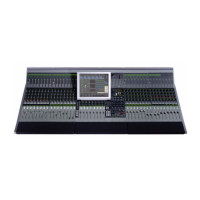89
Euphonix Max Air Mixing Console Operation Manual
Channels and StripsChapter 5:
Strips5.1
A CM416 module contains sixteen identical strips. The strip is the physical control area
on the console that contains keys, knobs, displays, and a fader. A Channel performs
all of the signal processing (EQ, dynamics, routing, gain, etc.). Max Air has up to 194
channels, each of which may be assigned to a strip. A strip has room for Swap and Main
channels that can be switched with one key press. Max Air allows tremendous exibility
with how strips are assigned channels and how they are controlled:
Any channel can be assigned to any strip; assignments need not be consecutive.•
Channels with related functions, such as all VTRs, can be assigned to neighboring •
strips.
Two strips can control one channel, allowing convenient access to that channel •
from two locations.
Channel-to-strip assignments can be named, stored, and recalled as • Layouts (see
Layouts on page 157).
Channel settings (EQ, dynamics, routing, gain, etc.) can be named, stored, and •
recalled as Snapshots (see Snapshots on page 159).
Max Air channels are mono unless they are dened as stereo, LCRS, 5.1, 6.1, 7.1 •
formats through Multi Format Masters (see Chapter 8: Control Groups and Multi
Format Masters).
A 96-channel, 48-strip conguration could assign all channels to the control surface:
Main (channels 1–48 to strips 1–48); Swap (channels 49–96 to strips 1–48). A 96-chan-
nel, 32-strip Max Air conguration cannot assign all channels to the console at once but
could use two Layouts to easily interchange the channels. Figure 5-1 shows a strip with
its bus displays that appear on the surface above the channel, and block diagrams for the
Swap and Main channels.
NOTE: The term “active channel” will be used throughout the manual to refer to the
Main or Swap channel currently assigned to the fader.

